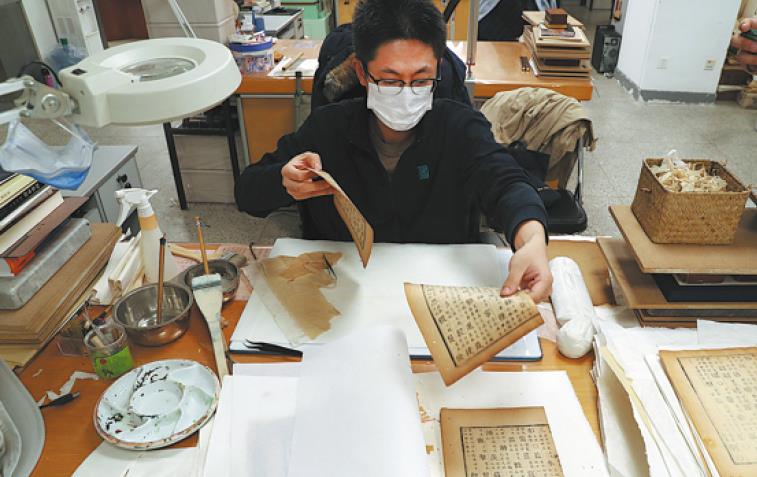Book restorers bound to saving the past


Ink rubbings
The NLC is now home to some of the country's best-known literary treasures.
For example, 16,000 Dunhuang manuscripts dating to the Tang Dynasty (618-907), which were found in one of the Mogao Caves in Gansu province in 1900, are crucial witnesses to frequent cultural communication along the ancient Silk Road. They include the Yongle Dadian, which was the world's largest paper-based general encyclopedia and was edited following an edict from a Ming Dynasty (1368-1644) emperor in the early 15th century.
Some special collections are difficult for the public to understand, but they bear early signs of ancient Chinese civilization that have been passed on to the present day.
Inscriptions on oracle bones from the Shang Dynasty (c. 16th-11th century BC) are the earliest-known Chinese characters. These bones are mainly turtle shell and ox scapula, or shoulder blade, and the inscriptions were primarily used for records or telling fortunes. Today's Chinese writing system is the result of the continuous evolution of these characters.
There are 35,651 oracle bone fragments at the NLC-the biggest collection in the world. In 2017, the inscriptions were listed in the UNESCO Memory of the World Register program.
Yuan Yuhong retired from the NLC this year, but the librarian occasionally returns to the venue for an oracle bones exhibition, when she demonstrates how ink rubbings of these fragments are taken.
"The fragments are deeply rooted in my life. The skill has passed from one generation to another, and I'm a third-generation practitioner at the library. I miss making the rubbings," Yuan said.
In China, ink rubbing is a traditional method used to reproduce characters from stele inscriptions or stone carvings. Practitioners place pieces of paper on the surface and then rub the paper to obtain an impression. In this way, many precious works of calligraphy survive even after the original stones disappear over time.
Rubbing oracle bones is more challenging work though, as Yuan points out, due to different-sized bones and characters. Many inscriptions are also too small to be read.
In the 1960s, the NLC launched a system to enable ink rubbings of oracle bones, aimed at replicating the earliest characters. Yuan joined the library in 1986, but never expected to remain there for decades.
"In the first year, I was not allowed to touch the bones. I fully understood this requirement. Once a drop of ink oozed through the paper, it would damage the precious oracle bones. Our duty was to protect them, but if we made a mistake, it would result in damage," Yuan said.
She practiced rubbings on various materials until being allowed to touch some makeshift bones as a final rehearsal, which took several more months.
"I had to find the right degree of strength to use. After all, bones are not as hard as stone," Yuan said.
Thanks to years of practice, every step required to make rubbings became instinctive for Yuan. Due to her efforts, rubbings from all oracle bones at the NLC have been completed. She has also cataloged the bones.
Although her efforts over the years have greatly helped scholars' research, Yuan still has her concerns, as there are now no more oracle bones at the library available for the younger generation of librarians to replicate.
"However, I'm sure there will be new ways to pass down this skill to the public," she said, while demonstrating her expertise at the exhibition.
This year, the rubbing of oracle bones was listed as an intangible cultural heritage of Beijing-the ideal retirement gift for Yuan.
























